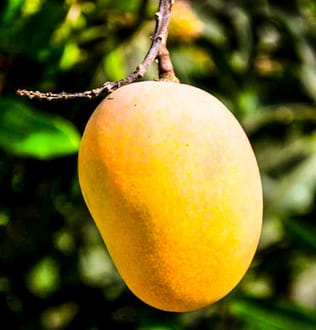Essay on Mango

Introduction
Mango is one of the most popular fruits. The word “mango” is taken from a Portuguese word “Manga”. Mangifera indica is the scientific name of mango which has been cultivated since ancient times in the tropical region of Asia. Now there are two different types of modern mango cultivation namely “Indian variety” and "Southeast Asian variety". In addition to being sweet, soft and juicy, the nature of mango has numerous health benefits that are worthy of its 'King of Fruits' proverb.
Description and Cultivation
Mango grows in tropical regions. The trees can grow up to 40 m tall with a crown about 16m in diameter. There are about 500 different types of mangoes so their size, shape, color, taste are also different. The trees grow well in well drained loam soil. The flowers begin to bloom from January. The pinkish white colored flowers have five petals with a mild, sweet aroma. The shape of mango is oval and can be round or heart shaped with 8 to 12cm long. Raw mango is dark green in color but when it ripe, it turns into reddish yellow, yellow, yellowish orange in color. The skin of the ripe mango is very smooth, waxy and fragrant. Inside the mango, has a large flattened seed about 4 to 7cm long. More than 283 types of mangoes grow in India, in which 30 types are famous. The well-known mangoes are Alphonso, Saffron, Himsagar, Dashari, Badami, Bombay Green etc.
Mango Mango originated in India, more than 4,000 years ago and 75% of mangoes grow in Asia. The major mango producing states in India are Uttar Pradesh, Karnataka, Tamil Nadu, Andhra Pradesh, Gujarat and Bihar. Uttar Pradesh is the highest mango growing state in India. Mango is now grown mostly in frost-free tropical and subtropical climates. Now mangoes grow in West Africa, Americas, Spain, Australia etc.
Benefits of mango
Mango provides many impressive health benefits. Mangoes contain vitamin A, vitamin K, vitamin C, minerals and antioxidants. Vitamin K helps our blood to clot as well as prevent anemia. Vitamin C plays an important role in building healthy collagen and blood vessels and improving our immunity power. Mango pulp is rich in beta-carotene which is an antioxidant and reduces the risk of cancer. Mango is rich in magnesium and potassium which help to maintain our blood pressure and keep our heart healthy. Mangoes also help to improve digestion, boost immunity power and eye health. A mango can supply up to 40% of daily dietary fiber requirement.
What can be made from mango
Mango can be eaten raw or ripe. We can make many delicious recipes from mangoes like ice cream, mango kulfi, mango yogurt, mango shake, mango lassi, mango salad, mango cake, chutney, jam, murabba, pickles, mango pudding, mango panna cotta and many more.
Conclusion
Mango, the national fruit of India, is a symbol of prosperity and love and is called the king of fruit because of its color, taste and aroma. The tree is also sacred to Buddhists because it is believed that Lord Buddha instantly created a large mango tree from seed at a place called Sravasti during his lifetime. Ambika, a Jain goddess, is traditionally represented as sitting under a mango tree. Mango leaves are used in many rituals and worships. Amir Khosrow who was an Indo-Persian scholar was very fond of mango and termed it "The Most Beautiful Fruit Of Hindustan". Rabindranath Tagore wrote the poem “Aamer monjori” to express his fondness on mango and its flowers.


.jpg)














0 Comentarios:
Post a Comment
Please do not use any abusing words or enter any spam links in the comment box